Ethanol emits more greenhouse gasses than the gasoline it is supposed to replace. Additionally, ethanol (corn) farms greatly under-utilize one of the greatest resources we have – land.
Of the ~92 million acres of corn planted in the US each year, roughly 40 million acres (1.6% of the nation’s land) are primarily used to feed cars and raise the octane of gasoline. If this land were repurposed with solar power, it could provide around three and a half times the electricity needs of the United States, equivalent to nearly eight times the energy that would be needed to power all of the nation’s passenger vehicles were they electrified.
However, if we were to transition this 40 million acres are of fuel to solar+food (agrivoltaics) – we could still meet 100% of our electricity needs, and power a nationwide fleet of electric vehicles.
Recent research from the Lawrence Berkeley National Laboratory suggests that utility scale solar power in the United States generates between 394 and 447 MWh per acre per year. (For this document we’ll assume a more conservative 350 MWh/acre)*. Thus, just one acre of solar panels provides enough energy to propel America’s most popular electric vehicle – the Tesla Model Y – nearly 1.3 million miles each year.
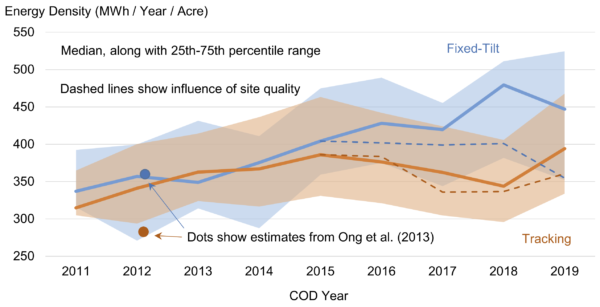
LBL
In a good year, one acre of corn is expected to generate around 328 gallons of ethanol. Since ethanol contains only ⅔ the energy of gasoline, a comparable crossover SUV averaging 30 miles per gallon would travel only 6,600 miles per year on that acre of corn.
That’s not a typo. solar panels produce roughly 200 times more energy per acre than corn. This striking figure makes an ironclad case in favor of converting vehicles to electricity – and that’s before we take into account the environmental and health benefits which would result from the profound reduction in emissions.
The ‘recent’ news that US ethanol emits 24% more emissions than gasoline, is in fact old news. Politics in the United States, influenced by agricultural industries, fossil-fueled fertilizer manufacturing, and perhaps a well-intentioned ulterior motive of underwriting food for national security, has led to a massive subsidy program for corn growers.
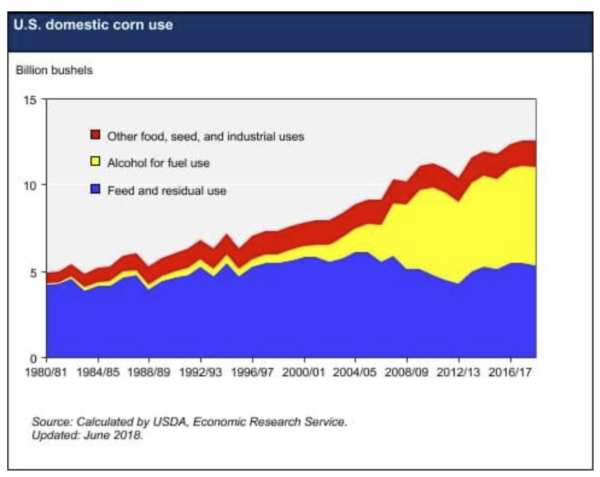
In fact, since 1980, pretty much all of the additional acres used to grow corn have gone towards fueling vehicles, not humans. We need not point fingers at farmers – they simply produce what the market demands. But these demands, which our civilization imposes on our soil, have resulted in far-reaching consequences.
Corn is particularly adept at siphoning nutrients from our soils. Restoring these nutrients requires fertilizers sourced from fossil-fuel feedstocks and produces more CO2 emission than any other human-driven chemical process on earth. Meanwhile, solar can help alleviate our nitrogen-fixation emissions crisis as well, by pulling fertilizer out of thin air.
With these factors in mind, we propose a new national security initiative – one that combines solar electricity generation with food production in order to solve many issues in one fell swoop. We urge landowners, developers, and legislators to prioritize the replacement of ethanol field corn with agrivoltaic operations. These operations should specifically target locations with the highest risk for fertilizer runoff. It’s time to bring our agrarian society into the 21st century.
And, just for the sake of fuel security, let’s incorporate some hydrogen generation into the picture as well.
#AgrivoltaicsforEthanol
Forty million acres of ethanol field corn could be used to generate 14 petawatt hours of solar electricity, if deployed in standard, highly efficient installation techniques. A reminder – that’s 3.5 times more energy than the current U.S. electricity consumption.
However, that is not our goal.

Even though we’re still in the nascent stages of agrivoltaic development, it’s fair to say that solar plus food facilities will generate at least half the amount of electricity per acre as we leave space for farming machines. One analysis from Germany found potatoes could be grown at 80% of their initial volume, while electricity could also reach 80% of its potential.
In the scenario where we only get 50% of the solar output from the land, our repurposed acres would generate around 7 petawatt hours of electricity per year. That’s eight times the amount of electricity required (~0.88 PWhrs/year) to push 3.26 trillion passenger car miles in the US every year, and enough left over to electrify the nation 1.5 times over.
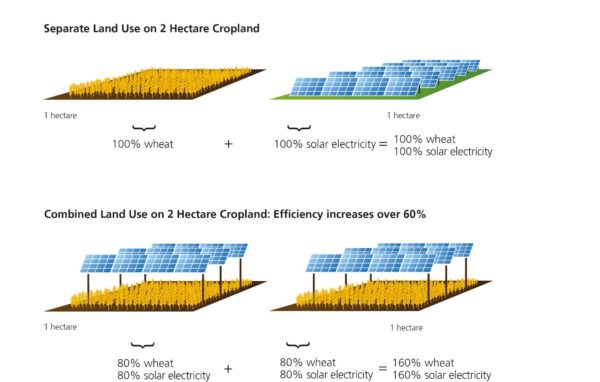
Of course, we don’t need (or probably want just yet) to power the US only via solar power. Thus we suggest powering the nation with only 50% solar – thus setting our electricity for our cars and our general power use around 16-21 million acres.
If we’re going to be honest about electrification, we must admit to ourselves that the 40 million acres of corn we blend with our gasoline is obstructing this path. But if we want to support our farmers, while generating massive amounts of local, secure, clean – and as sure as the sun rises – predictable electricity pricing, we must consider trading our ethanol for agrivoltaics.
#AgriovoltaicsforEthanol
*There are several caveats to this article.
For instance, this author’s interpretation of the solar capacity and electricity per acre per year research is on the higher end of the estimations (currently), as the research quoted focused specifically on land used for solar power – but less so on the land supporting the solar. One estimation from a respected modeler suggested we use a value of 220 MWh/acres/year – 37% lower than this article’s 350 MWh/acre/year, and roughly one half of the 447 MWh/acre/year value in the research paper quoted.
Another debate is the exact number of acres should we specifically say are ethanol acres – this is something researched by many, and can change based on the source.
Additionally, many questions related to energy storage scaling, high voltage power lines deployment, scheduling the charging of EVs, energy losses in charging/discharge, and whether or not to use solar energy to generate and compress hydrogen remain. Many paths are possible, but first we must eliminate the archaic notion that corn acreage is sacrosanct.
This content is protected by copyright and may not be reused. If you want to cooperate with us and would like to reuse some of our content, please contact: editors@pv-magazine.com.
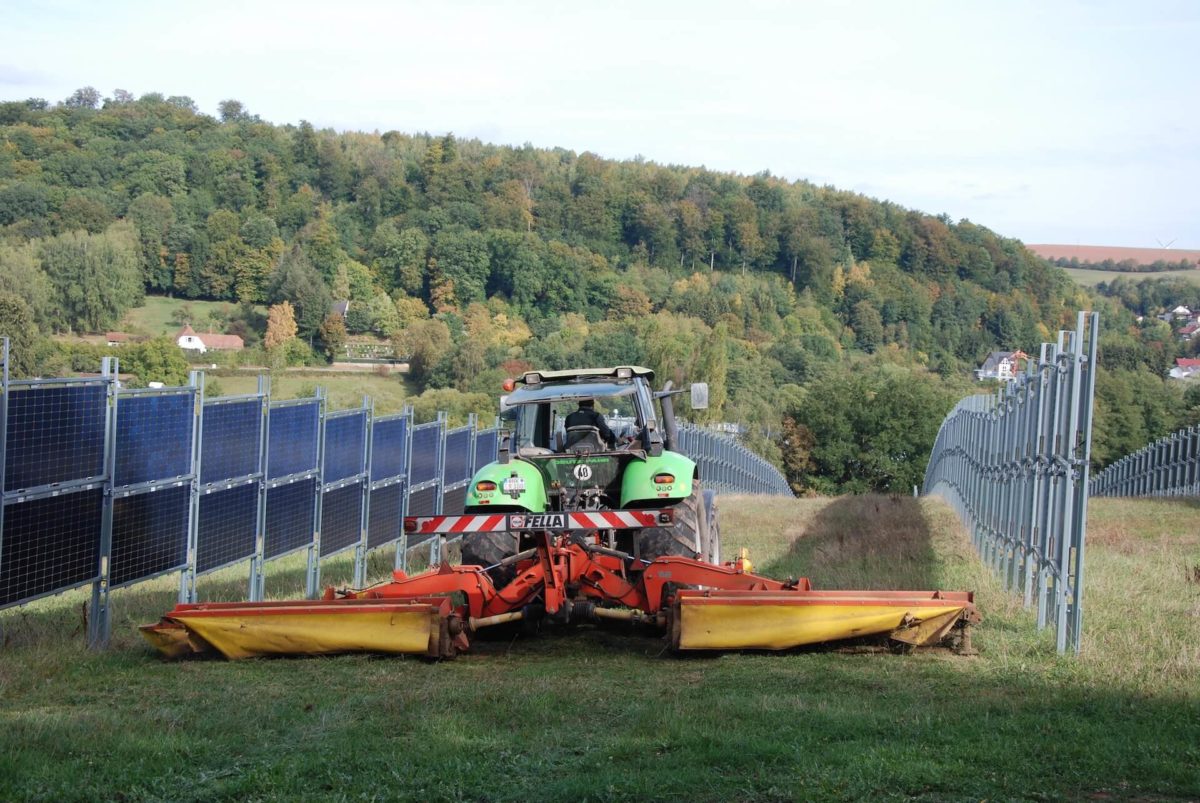
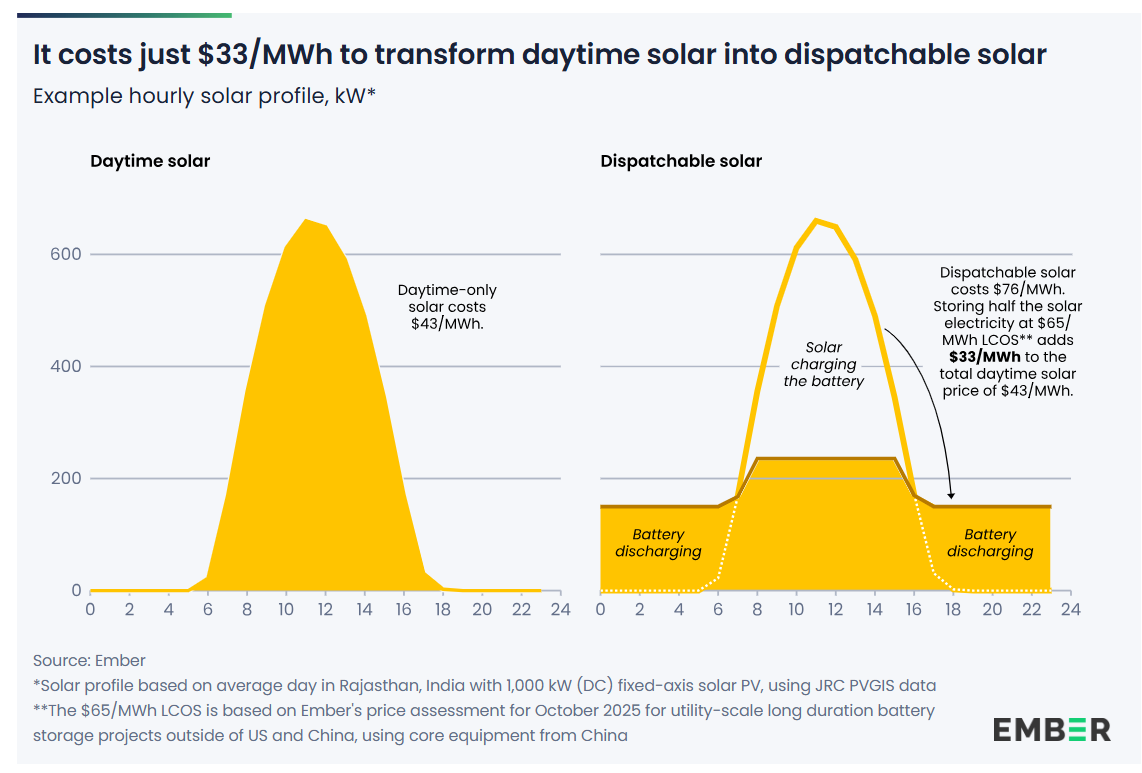





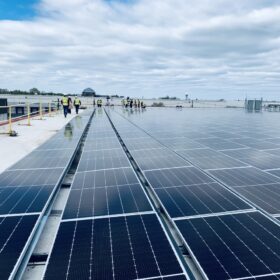
Great article John!
Ty Dr
Prime farmland that can grow food is scarce when the whole world is taken into consideration. There is still a hungry world to feed. Instead of converting cropland to solar, use parking lots, rooftops, and low quality land. Vehicle electrification will reduce ethanol demand on its own. The 5 billion bushels of corn going to ethanol can become food or not be grown on marginal, irrigated land. No Colorado River water should be used for corn, soybeans, or other crops that grow in wetter regions.
This article is talking about PV with crop use around it. See the tractor driving between these panels? According to the article:
Germany found potatoes could be grown at 80% of their initial volume, while electricity could also reach 80% of its potential.
If that is true it way better then land being used for ethanol.
1. Agrivoltaics can reduce output of corn or wheat but actually increase the output of pastures and horticulture, due to shading and windbreak effects.
2. It is not necessary to convert cornfields one for one for one into solar farms. Some of the farms close to transmission will be converted to agrivoltaic still with corn or other grains, most will continue to grow corn and other grains, while grazing and lower grade cornfields in other areas will be used for the necessary solar
Re the new study that showed that ethanol emits more greenhouse gases:. It’s always interesting to see that ethanol plants all run on natural gas for the cookers, etc. If they used their own ethanol to power their plants, they wouldn’t have much to sell to their guaranteed (by federal law) gasoline market. But I digress:
Be careful with the comparison numbers on acreage use for corn vs photovoltaics. The residue from the ethanol production process are the spent grains from the brew mash. These distillers grains are a high quality, high protein feed that has become a highly desired staple of cattle and hog production. If they were not available, then much of the land now used for ethanol would still grow corn or soybeans for livestock production. Half maybe? Each 48 lb bushel of corn produces 17 lbs of DDGs (dried distillers grains) which has the protein of the whole bushel, but missing the carbohydrates that were converted to alcohol.
None of this is said in support of ethanol. It is in the interest of accuracy.
Thanks for the info. You learn something every day
Sad to see such inaccurate studies and it being publicized.
John, those corn acres produced 7x more products including much high food value food, corn oil, etc everyone ignores.
Fact is ethanol is only 15% of the products that come from that field of corn. Yet you put all the input, land, etc cost on ethanol?
So the ethanol takes food away is not true, it supplies much better food.
What this is doing is spreading big oil, auto propaganda.
Next we have lots of far better places for solar and where is will be because people want to generate their own power, will be on roofs , etc at homes, buildings and businesses.
Where solar makes, saves retail costs.
So how about an article on the real cost of ethanol after the products take their share of inputs to make up for this one?
And finally no most studies have not found ethanol uses more energy than it takes. EPA and many others show that are not paid, influenced FF studies.
That knowledgeable people like you think ethanol is bad shows just how successful big oil, auto has been.
The fastest way to fight for Ukraine would everyone who can use E-85 so we don’t have to export 100mm gals/month. And most pickups, light trucks, other cars can run on it.
It also makes American jobs, and away from Putin, Saudis, etc pockets.
The best way we can help Ukraine, fight Putin is use E-85 as many pickups, other trucks, some cars can and conserve as much oil, NG as we can.
Glory to Ukraine.
John’s article appears well researched and contains data which directly cites research by reputable scientists. While I would certainly be open to considering your counter-argument, your assertions fail to cite any studies or available data. The burden of proof was on you – John already backed up his claims.
Also, it is extremely unclear how an article that demonstrates one (of many) ways to electrify the nation, based on hard data, could in any way be “spreading big oil, auto propaganda”. I cannot construct a coherent worldview from this assertion, especially when I consider your bizarre and emotionally charged political implication – that (inevitably) burning natural gas to make ethanol is somehow a better way to fight Putin/Saudis than electrification.
I don’t believe your claims supported by any data at all. I suspect this data either does not exist, or would need to be cherry-picked to support such assertions.
Also – forgot to include – today, the Atlantic released a well-researched article that directly refutes these geopolitical implications.
https://www.theatlantic.com/ideas/archive/2022/03/gas-prices-ethanol-subsidies-putin/627053/
While it is true that there are useful byproducts from Corn ethanol and the US grows far more food than it needs anyway so neither biofuels of solar or wind for that matter reduce food production.
However I think your 15% is wrong, because at least 2/3rds of corn grown does not go near an ethanol plant, it is used for human or animal food and food products. Of the corn used for ethanol production at least half the value and therefore at least half the costs should be attributed to ethanol.
In the short term increased use of E85 and biodiesel for transport and coal for power generation may be a necessary thing, but in the medium to long term, energy efficiency and expanded renewables installation is much more effective. Almost every MW of wind and solar capacity installed reduces gas use by an average of 17m cubic feet per annum. China installed 120,000 MW of wind and solar last year, why can’t the US do that. 120 MW of wind and solar would produce about 250 TWh of electricity which would reduce gas fired electricity by about 16% freeing up about . The US currently produces about 25m tons of corn ethanol per year. In simple terms if it was burnt in gas turbines to produce electricity it would produce 60-70 TWh of electricity.
Alternatively if methanol production was increased by 50% the extra 12,500,000 tons of methanol would displace about 12 m tonnes of crude or about 7 m tonnes after fuel used in planting harvesting, transport and processing, the US uses about 870 m tons of petroleum products per year of which about 5m tonnes from Russia so an 18- 20 m acre increase in corn plantings would be needed to displace Russian Oil, it can be done because the US has more than sufficient cropland to do it, but freeing up US gas for export by rapidly increasing wind, solar and energy efficiency and temporarily increasing coal power generation would be quicker and more cost effective
Very good idea (solar+food). Hope this is expanded.
Lets not forget about the elephant in the room (USA) though– the Nevada Nuclear test (former) site.
Hundreds of square miles of sun drenched, slightly contaminated land. A Terra-watt size power station+storage awaits.
Solar is high maintenance enough as-is. Putting panels into a field that turns into a mudbath every spring would be a regular maintenance nightmare.
Might be viable in warm climates, but not where most corn is grown.
The US already grows about 40% more food than it uses and it has typically 50-60m acres of cropland lying fallow so land availability is not an issue. You are right however that methanol/biodiesel can and should be made from farm, forest and urban waste rather than purpose grown crops.
Some if not all of the studies that bash ethanol are funded by oil producers and distributors. It is very obvious, however, if you look around the northeastern United States that there are many areas that are now woods that used to be firms. It is in no way clear that, if all of the land presently used to grow field corn for ethanol was converted to solar farms that the land would be in optimal use. However, it is surely true that there would be fewer farmers.
The new study on ethanol was from University of Wisconsin, not a fossil fuel company. It was published in the Proceedings of the National Academy of Sciences. This is not Prager “University” claptrap.
Agrivoltaics mix food production with solar power. Like monoculture farming has a lot of drawbacks, so does converting tillable land to solar farms. Good land should be used for crops. Marginal pasture land can be a mix of grazing and solar panels. It is already being done successfully.
In the near future we will need food much more than fuel. Ethanol only makes sense if it is made from the farm waste products–NOT the crop itself. I believe this is doable…but more challenging.
While Corn isn’t the best crop for agrivoltaics, you can still make it work for corn without loss of corn yields, actually you can get a slight increase in yield!
“This article concerns research conducted at a 100-m2 experimental farm with three sub-configurations: no modules (control), low module density, and high module density. In each configuration, 9 stalks/m2 were planted 0.5 m apart. The biomass of corn stover grown in the low-density configuration was larger than that of the control configuration by 4.9%. Also, the corn yield per square meter of the low-density configuration was larger than that of the control by 5.6%.”
https://www.agrisolarclearinghouse.org/solar-sharing-for-both-food-and-clean-energy-production-performance-of-agrivoltaic-systems-for-corn-a-typical-shade-intolerant-crop/
The same applies with wheat, you just need to find a good balance and the outcome is increased yield, less water usage all while generating electricity. And yes, you can even produce fertilizer on-site